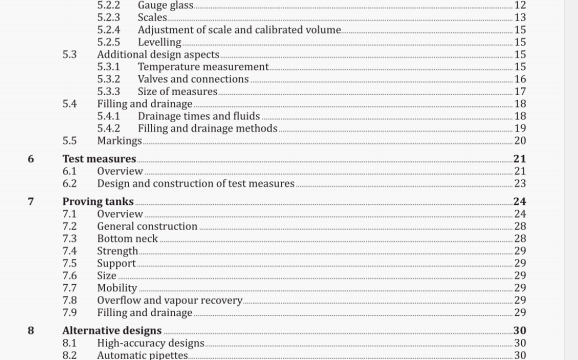ISO 8222 pdf download – Petroleum measurement systems一 Calibration – Volumetric measures, proving tanks and field measures (including formulae for properties of liquids and materials).
5.4 Filling and drainage
5.4.1 Drainage times and fluids
Volume measures have a defined capacity between the full and empty datum. This defines the nommal volume of a measure to contain when dry. When a measure is Filled then emptied, residual fluid clings to the wall, slowly draining away over time. Most test measures and proving tanks are used to deliver, hence wetted, The calibrated volume is therefore to deliver. Initially the nominal volume of a measure may be shown as either the volume to contain or the volume to deliver, which could differ from the calibrated volume to be referenced in use.
To obtain reliable and consistent measurements the measure is first filled then emptied for a consistent length of time. This drain time is defined during the initial calibration of the tank and then used for subsequent calibrations and when the measure is In use. The drain time is recorded in the tank records and calibration certificates and should also be clearly defined on the marking plate.
Drainage of Invertible test measures Is specified by both a time and a method. Draining an Invertible measure is done by pouring from one side of the neck until cessation of the main flow then inverting vertically for the specified final drain time. For standard test measures the final drain time should be 10 s. Some regulations for standard measures and particular liquids require a first drain (pour) time to be 30 s. For this and other specifications the main flow time and angle of pour should be conItcnt and specified in the operating procedures, calibration certificates and reports of calibrations using the measure.
Many test measures and smaller proving tanks with bottom drains have a single-stage drain time. This requires the drainage to be through a defined valve setting and drain pipe arrangemeni This is usually draining through a fully open valve and short straight length of pipe to a container without restriction. Such measures should have no restrictions or alterations made to the outlet from the drain valve. The drain time Is specified as the time between opening the valve to when the valve Is closed, It can be a specified time or be defined in a similar way to a final drain time.
Other measures and proving tanks may have the drain time dIvided into two stages: I) the first drain time where the majority of the liquid is drained at a high flowrate; ii) the final drain time where the last of the liquid is drained out to leave a consistent residual volume. Each stage can have a defined time, tolerance on the time and a defined method assigned to it.
The first drain time reflects the time allowed to empty the tank of most of the content. A significantly fast or slow drain time due to variations and differences in the drain pipework can affect the residual volume in the tank. For this reason it is advisable to drain the fluid with the drain valve fully open. The first drain time is not usually critical and a wide tolerance is allowed. It is good practice to specify the allowable range of first drain time In the design and In the operating procedures. It Is also good practice to record the first drain time and description of the pipework on the calibration certificate and subsequently when using the measure.
Typical first drain times lie in the range of 10 s to 180 s for prover tanks. It is also advised to have the tall late of the level of liquid in the body ofa measure exceed I cm/s.
Cessation of the first drain time, hence the start of the final drain time, should be identified, defined and recorded in the calibration certificate and the operating procedure.
Specifying the end of the first drain time varies with tank design and use. Common options to detine the end of the first drain time are as follows:
a) For an invertible measure, main flow is defined by pouring from one edge until the flow breaks Into drops.
b) For a proving tank, where there is an open drain, main flow ceases when the flow breaks into drops.
c) For a proving rank with a closed drain and a window, sight glass or weir, the main flow ceases when the flow breaks into drops.
ISO 8222 pdf download – Petroleum measurement systems一 Calibration – Volumetric measures, proving tanks and field measures (including formulae for properties of liquids and materials)
